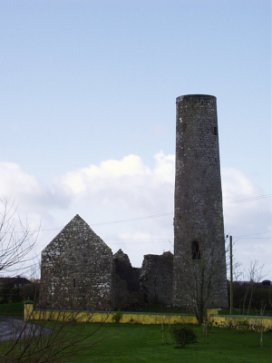| Altar Stone
According to parish records, there was an altar stone in Croom, which
dated from penal times. This altar stone bore an ogham inscription. It
was given by Canon Wall to the National Museum.
Dysert Aenghusa

© Dysert Aenghusa
Dysert Aenghusa is the earliest known Christian site in
the area of Croom, dating from approximately 800AD. The ruins of a church
and of a round tower are now all that remains. There was a graveyard here
until about 100 years ago, although no trace of it now remains. A 19th
century landowner used the headstones as slabs to cover drains. A local
story told about the man says that he built new sheds on his farm soon
after, and "Luke Christy went broke over the sheds". Some say
his financial failure was punishment for disturbing the graveyard.
According to Barrow's The Round Towers of Ireland, Luke Christy excavated
the interior of the tower in 1849. He also fitted floors and ladders and
a lead roof. The roof was replaced in 1881-2 when the Office of Public
Works carried out repairs. The ruin is now under the protection of the
OPW and is well preserved. Mass was said here last year.
Aengus was born around 750AD. He joined the monastery of Clonenagh, near
Portlaoise, and was ordained a priest around 775AD. At this time the Céilí
Dé (Companions or servants of God) were a kind of order of hermits.
Aengus became one of the Céilí De, and so sought out a lonely
place to set up his dísert or hermitage. He came to Croom around
780AD and set up his hermitage at what is now known as Dísert Aenghusa
in the townland of Carrigeen in Croom. There, Aenghus founded a church
before moving on after a stay of just two years.
There is much confusion as to the dates on which the church and tower
were built. Some would date the church from the 9th or 10th centuries,
while others would date it as late as the 15th or 16th centuries, and
say that the later ruin incorporates the first building into its framework.
The tower has been dated as early as the tenth century, and as late as
1200AD. The church was used as a parish church until 1418. By 1610 Dísert
belonged to the Protestant church.
A mass path in this area leads from Dysert Aenghusa to Croom.
 
|